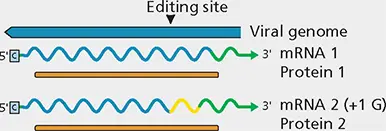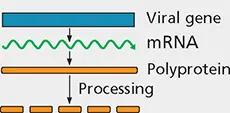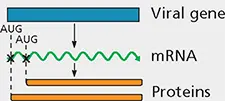| Mechanism |
Diagram |
Virus |
Chapter(s) |
Figures in appendix |
| MultiplesubgenomicmRNAs |
 |
Adenoviridae Hepadnaviridae Herpesviridae Paramyxoviridae Poxviridae Rhabdoviridae |
7, 87, 107676 |
1, 211, 1217, 1825, 2631, 32 |
| Alternative mRNA splicing |
 |
Adenoviridae Orthomyxoviridae Papillomaviridae Polyomaviridae Retroviridae |
7, 887, 8810 |
1, 215, 1623, 2429, 30 |
| RNA editing |
 |
Paramyxoviridae Filoviridae Hepatitis delta virus |
6, 888 |
|
| Information on both strands |
 |
Adenoviridae Polyomaviridae Retroviridae |
7-97-910 |
1, 223, 2429, 30 |
| Polyproteinsynthesis |
 |
Alphaviruses Flaviviridae Picornaviridae Retroviridae |
6, 116, 116, 116, 11 |
33, 349, 1021, 2229, 30 |
| Leaky scanning |
 |
Orthomyxoviridae Paramyxoviridae Polyomaviridae Retroviridae |
11111111 |
15, 1629, 30 |
| Reinitiation |
 |
Orthomyxoviridae Herpesviridae |
1111 |
15, 16 |
| Suppression of termination |
 |
Alphaviruses Retroviridae |
1111 |
33, 3429, 30 |
| Ribosomalframeshifting |
 |
Astroviridae Coronaviridae Retroviridae |
111111 |
5, 629, 30 |
| IRES |
 |
Flaviviridae Picornaviridae |
1111 |
21, 22 |
| Nested mRNAs |
 |
Coronaviridae Arteriviridae |
66 |
5, 65, 6 |
Figure 3.10 Information retrieval from viral genomes. Different strategies for decoding the information in viral genomes are depicted. CBF, CCAAT-binding factor; USF, upstream stimulatory factor; IRES, internal ribosome entry site.
The utility of viral genome sequences extends well beyond building a catalog of viruses. These sequences are the primary basis for classification and also provide information on the origin and evolution of viruses. In outbreaks or epidemics of viral disease, even partial genome sequences can provide information about the identity of the infecting virus and its spread in different populations. New viral nucleic acid sequences can be associated with disease and characterized even in the absence of standard virological techniques (Volume II, Chapter 10). For example, human herpesvirus 8 was identified by comparing sequences present in diseased and nondiseased tissues, and a novel member of the parvovirus family was identified as the cause of unexpected deaths of laboratory mice in Australia and the United States.
Despite their utility, genome sequences cannot provide a complete understanding of how viruses reproduce. The genome sequence of a virus is at best a biological “parts list”: it provides some information about the intrinsic properties of a virus (for example, predicted sequences of viral proteins and particle composition), but says little or nothing about how the virus interacts with cells, hosts, and populations. This limitation is best illustrated by the results of environmental metagenomic analyses, which reveal that the number of viruses around us (especially in the sea) is astronomical. Most are uncharacterized and, because their hosts are also unknown, cannot be investigated. A reductionist study of individual components in isolation provides few answers. Although the reductionist approach is often the simplest experimentally, it is also important to understand how the genome behaves among others (population biology) and how the genome changes with time (evolution). Nevertheless, reductionism has provided much-needed detailed information for tractable virus-host systems. These systems allow genetic and biochemical analyses and provide models of infection in vivo and in cells in culture. Unfortunately, viruses and hosts that are difficult or impossible to manipulate in the laboratory remain understudied or ignored.
The “Big and Small” of Viral Genomes: Does Size Matter?
The question “does genome size matter” is difficult to answer considering the three orders of magnitude in genome length that separate the largest and the smallest viral genomes. The two largest viral genomes known are those of Pandoravirus salinus (2.4 million bases of dsDNA) and Pandoravirus dulcis (1.9 million bases of dsDNA), encoding 2,541 and 1,487 open reading frames, respectively. The largest RNA virus genomes are far behind ( Box 3.4). At the other end are anelloviruses, with a 1,759-base ssDNA genome encoding two proteins ( Fig. 3.3B), and viroids, circular, single-stranded RNA molecules of 246 to 401 nucleotides that encode no protein (Volume II, Chapter 13). Anelloviruses include agriculturally important pathogens of chickens and pigs and torque teno (TT) virus, which infects >90% of humans with no known consequence. Viroids cause economically important diseases of crop plants.
All viruses with genome sizes spanning the range from the biggest to the smallest are successful as they continue to reproduce and spread within their hosts. Despite detailed analyses, there is no evidence that one size is more advantageous than another. All viral genomes have evolved under relentless selection, so extremes of size must provide particular advantages. One feature distinguishing large genomes from smaller ones is the presence of many genes that encode proteins for viral genome replication, nucleic acid metabolism, and countering host defense systems. When mimiviruses were first discovered, the surprise was that their genomes encoded components of the protein synthesis system, such as tRNAs and aminoacyl-tRNA synthetases. Tupanviruses, isolated from soda lakes in Brazil and deep ocean sediments, encode all 20 aminoacyl-tRNA synthetases, 70 tRNAs, multiple translation proteins, and more. Only the ribosome is lacking. Why would large viral genomes carry these genes when they are available in their cellular hosts? Perhaps by producing a large part of the translational machinery, viral mRNAs can be more efficiently translated. This explanation is consistent with the finding that the codon and amino acid usage of tupanvirus is different from that of the amoeba that it infects.
Читать дальше














